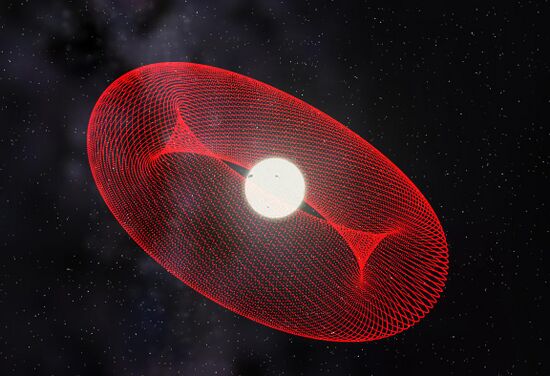Dyson Swarms (A1-0)
This article needs to be updated. The reason given is: Missing categories and wrong formatting style. (May 2024) |

Image from Steve Bowers on Orion's Arm.
A Dyson Swarm is a very large, orbital megastructure consisting of a "shell" of photovoltaic collectors or habitats around a star or another luminous natural object such as a brown dwarf, that collects most if not all of the star's energy output, in order to use it for other purposes. Dyson Swarms collect vast amounts of energy, which can be used to support many small habitats, or a number of larger habitats or inhabited megastructures. In some civilizations, such as the Confluence, Dyson Swarms are often used as processing nodes to support the vast minds of hyper-intelligent AIs.
Structure
Spherical Dyson Swarms, the largest and most notorious ones, are circumstellar swarms comprised of at least 10.000 orbital energy collector elements (although most have hundreds of thousands if not millions of elements) in progressively inclined orbits that create a sphere-like volume saturated with photovoltaic collectors and habitats around the star, typically a million kilometers thick. Dyson swarms vary in distances from their primary star, as well as having a varied individual habitat or structure density.
When used for power generation and/or computation, Swarms will be located as closest safe distance possible to their star, in order to collect the same amount of energy while requiring much less materials to be constructed. In the case of a standard, Sol-like star, this distance typically averages out to 0.1 AUs or less.
However, as far as reasonably comfortable (on baseline human-friendly standards) habitat-composed swarms are concerned, most of the swarm's elements might be a distance between 108 and 228 million kilometers around a standard, Sol-like star. Since part of the purpose of all this is to maximize interception of sunlight, most Dyson Swarms destined to habitation tend to be on the smaller side of this range.
The energy collected by Dyson Swarms is then beamed out towards the rest of the star system's worlds and habitats. This energy can either be transmitted directly to Optical Phased Arrays located on the planets and habitats, or it can be first passed through intermediary orbital reception OPAs that then beam it out. The Dyson Swarm's energy distribution to worlds and habitats is often times handled by autonomous systems.
Ring Swarms (Jenkin's Swarms)
A partial dyson swarm in which the component orbitals and other megastructures follow conventional orbits, each with a slightly different ascending node and pericenter. Together these orbits form a series of rings around their primary star, and are then adjusted so that the swarm forms a torus; several swarm tori can be arranged at right angles to each other to efficiently collect energy from the star. This configuration gives them longer term stability by ensuring that none of the elements will ever come close to each other, while still allowing most of the star's output energy to be captured.

Belt Swarms
The smallest dyson swarm configuration, in which only a thin band of orbital collectors collects the energy from the star. Even with a very high density of orbital collectors, the amount of energy collected by this configuration is only a small fraction of the star's total output energy, so Belt Swarms are typically found in the youngest and/or less advanced reaches of colonized space, whose star systems are more sparsely populated and thus require much less energy. Due to their total volume being much smaller and having much simpler orbits compared to other configurations, the orbital elements are typically much, much larger, consisting of incredibly thin photovoltaic sails hundreds of thousands of kilometers in size. Because of this, they do block out most of not all of the starlight in their orbital band, and so they are often inclined at angles of 15° or more to allow for starlight to hit the various worlds in their system. Another used solution is to simply reflect regulated amounts of starlight on the planets and habitats in question, although this tends to become less effective when habitats and other structures are not clustered together around worlds or in Lagrange Points.
Nicoll-Dyson Beams
The power of a collimated beam is limited by the focus of the beam when it reaches a distant target. One way to improve this focus is to increase the effective aperture of the emitter. A very large object, such as a Dyson Swarm, represents a very large effective aperture if used to emit such a beam. Dyson Swarms collect considerable amounts of energy from the stars they contain. If some of that energy can be stored, then directed towards a target in a different planetary system, considerable damage can result. In practice, the outermost elements of the swarm, or the outer surface of a dynamically supported Dyson Shell, become a phased array emitter. This allows a powerful beam to be focused on a distant target in another planetary system.
Starlifting Swarms
Swarms may be used to provide power for starlifting projects; the energy collected is used to power massive superconducting magnet rings, which stimulate the star to expel matter in the form of controlled polar jets. Additional light may also be redirected onto specific points on the star's surface (typically corresponding to areas of high megnetic flux) to heat up the local plasma and increase material lift-off.
Dyson Swarms In Sector A1-0
Sources
- Orion's Arm: https://www.orionsarm.com/eg-article/4845fbe091a18
- Orion's Arm: https://www.orionsarm.com/eg-article/464f886f7f338
- Isaac Arthur: https://youtu.be/HlmKejRSVd8?si=pHBBjbWMKas6bE_w
- Isaac Arthur: https://youtu.be/RjtFnWh53z0?si=furZqJJCYsX5id4w